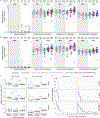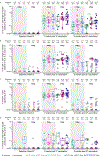Vaccination with mRNA-encoded membrane-anchored HIV envelope trimers elicited tier 2 neutralizing antibodies in a phase 1 clinical trial
- PMID: 40737434
- PMCID: PMC12478711
- DOI: 10.1126/scitranslmed.ady6831
Vaccination with mRNA-encoded membrane-anchored HIV envelope trimers elicited tier 2 neutralizing antibodies in a phase 1 clinical trial
Abstract
mRNA technology might accelerate development of an urgently needed preventive human immunodeficiency virus (HIV) vaccine. We evaluated the safety and immunogenicity of three mRNA-encoded envelope trimers, including two doses of soluble and membrane-anchored forms, in a randomized, open-label, phase 1 clinical trial. Vaccines were generally well tolerated, although 6.5% (7 of 108) of participants developed urticaria, a higher proportion than seen with other mRNA vaccines. mRNA-encoded trimers induced strong envelope-specific B and T cell responses. Immunization with membrane-anchored trimers, intended to obscure epitopes at the trimer base targeted by nonneutralizing antibodies, reduced the frequency of base-binding serum antibodies in comparison with soluble trimers. Three immunizations elicited autologous tier 2 serum neutralizing antibodies in 80% of vaccinees receiving the membrane-anchored trimers, in contrast to only 4% receiving the soluble trimer. Thus, with demonstration of more favorable safety, mRNA-encoded membrane-anchored HIV envelope trimers represent a promising platform for HIV vaccine clinical development.
Conflict of interest statement
Figures





References
-
- Gray GE, Mngadi K, Lavreys L, Nijs S, Gilbert PB, Hural J, Hyrien O, Juraska M, Luedtke A, Mann P, McElrath MJ, Odhiambo JA, Stieh DJ, van Duijn J, Takalani AN, Willems W, Tapley A, Tomaras GD, Hoof JV, Schuitemaker H, Swann E, Barouch DH, Kublin JG, Corey L, Pau MG, Buchbinder S, Tomaka F, I. 705/HPX2008 S. Group, Allagappen J, Andriesen J, Ayres A, Bekker L-G, Borremans C, Brumskine W, Chilengi R, Dubula T, Garrett N, Gelderblom H, Gill K, Hoosain Z, Hosseinipour M, Hutter J, Inambao M, Innes C, Kilembe W, Kotze P, Kotze S, Laher F, Laszlo I, Lazarus E, Malahleha M, Mathebula M, Matoga M, McClennen R, Mda P, Meerts P, Naicker V, Naidoo L, Philip T, Pitsi A, Scheppler L, Sopher C, Takuva SG, Viegas E, Weijtens M, Yuan O, Mosaic HIV-1 vaccine regimen in southern African women (Imbokodo/HVTN 705/HPX2008): a randomised, double-blind, placebo-controlled, phase 2b trial. Lancet Infect. Dis. (2024), doi: 10.1016/s1473-3099(24)00358-x. - DOI - PMC - PubMed
-
- NIH, Experimental HIV vaccine regimen safe but ineffective, study finds (2023) (available at https://www.nih.gov/news-events/news-releases/experimental-hiv-vaccine-r...).
-
- Leggat DJ, Cohen KW, Willis JR, Fulp WJ, deCamp AC, Kalyuzhniy O, Cottrell CA, Menis S, Finak G, Ballweber-Fleming L, Srikanth A, Plyler JR, Schiffner T, Liguori A, Rahaman F, Lombardo A, Philiponis V, Whaley RE, Seese A, Brand J, Ruppel AM, Hoyland W, Yates NL, Williams LD, Greene K, Gao H, Mahoney CR, Corcoran MM, Cagigi A, Taylor A, Brown DM, Ambrozak DR, Sincomb T, Hu X, Tingle R, Georgeson E, Eskandarzadeh S, Alavi N, Lu D, Mullen T-M, Kubitz M, Groschel B, Maenza J, Kolokythas O, Khati N, Bethony J, Crotty S, Roederer M, Hedestam GBK, Tomaras GD, Montefiori D, Diemert D, Koup RA, Laufer DS, McElrath MJ, McDermott AB, Schief WR, Vaccination induces HIV broadly neutralizing antibody precursors in humans. Science 378, eadd6502 (2022). - PMC - PubMed
-
- Steichen JM, Phung I, Salcedo E, Ozorowski G, Willis JR, Baboo S, Liguori A, Cottrell CA, Torres JL, Madden PJ, Ma KM, Sutton HJ, Lee JH, Kalyuzhniy O, Allen JD, Rodriguez OL, Adachi Y, Mullen T-M, Georgeson E, Kubitz M, Burns A, Barman S, Mopuri R, Metz A, Altheide TK, Diedrich JK, Saha S, Shields K, Schultze SE, Smith ML, Schiffner T, Burton DR, Watson CT, Bosinger SE, Crispin M, YatesIII JR, Paulson JC, Ward AB, Sok D, Crotty S, Schief WR, Vaccine priming of rare HIV broadly neutralizing antibody precursors in nonhuman primates. Science 384, eadj8321 (2024). - PMC - PubMed
Publication types
MeSH terms
Substances
Grants and funding
LinkOut - more resources
Full Text Sources
Medical

